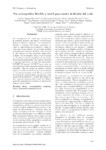Un exoesqueleto flexible y textil para asistir la flexión del codo

Use this link to cite
http://hdl.handle.net/2183/28389
Except where otherwise noted, this item's license is described as Atribución-NoComercial-CompartirIgual 4.0 Internacional
Collections
Metadata
Show full item recordTitle
Un exoesqueleto flexible y textil para asistir la flexión del codoAlternative Title(s)
A Portable Flexible Exoskeleton to Assist Elbow FlexionAuthor(s)
Date
2021Citation
Samper-Escudero, J.L., Cantalejo-Escobar, D., Pont-Esteban, D., Contreras-González, A.F., Ruiz, R., Blaya, F., Tapia, S., Sánchez-Urán, M.A., Ferre, M. Un exoesqueleto flexible y textil para asistir la flexión del codo. En XLII Jornadas de Automática: libro de actas. Castelló, 1-3 de septiembre de 2021 (pp.542-549). DOI capítulo: https://doi.org/10.17979/spudc.9788497498043.542 DOI libro: https://doi.org/10.17979/spudc.9788497498043
Abstract
[Resumen] Los exoesqueletos son robots que circunscriben la anatomía humana para asistir su locomoción. Entre las distintas categorías, los exoesqueletos flexibles o exotrajes (del término anglosajón exosuit) se caracterizan por su ligereza y bajas restricciones
al movimiento. Los exotrajes emplean principalmente elementos flexibles, como tela, por lo que carecen de una estructura rígida autoportante. Por el contrario, estos robots se apoyan en el sistema musculo-esquelético al que transfieren fuerzas asistenciales. Este artículo describe el sistema para flexar el codo del exoesqueleto LUXBIT. El proyecto LUXBIT busca crear un exoesqueleto portable para asistencia de tareas bimanuales. Para ello emplea un sistema textil de agarre y transferencia de fuerzas al usuario basado en un esquema de polea móvil. El uso de métodos de costura ha proporcionado una solución compacta, fácil de mantener y versátil. Este diseño reduce la presión aplicada sobre la piel. Los últimos apartados muestran los resultados de aplicar el sistema en cuatro sujetos. [Abstract] Exoskeletons are robots that surround the human anatomy to assist locomotion. Flexible exoskeletons, so-called exosuits, use soft materials and actuation methods to deliver a lightweight and unobstrusive construction. Their lack of a rigid self-supportive structure requires them to support their functioning on the users’ anatomy. This paper covers the mechanism to flex the elbow used by the flexible exoskeleton LUXBIT. The LUXBIT project aims to attain a flexible portable exoskeleton to assist the arms in bimanual tasks. The exoskeleton has a textile coupling that combines fabrics’ stacking and sewing patterns to transfer mobilising forces to the user. The actuation’s compactness has been achieved by applying tailoring methods. The resulting design is versatile, easy to maintain, and does not apply pressure to the skin constantly. The last sections evaluate the exoskeleton in four healthy subjects.
Keywords
Exoesqueleto
Exotraje
Robot
Interación humano-robot
Exoskeleton
Exosuit
Human-robot interaction
Exotraje
Robot
Interación humano-robot
Exoskeleton
Exosuit
Human-robot interaction
Editor version
Rights
Atribución-NoComercial-CompartirIgual 4.0 Internacional
ISBN
978-84-9749-804-3






